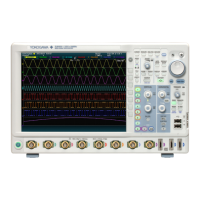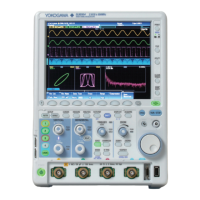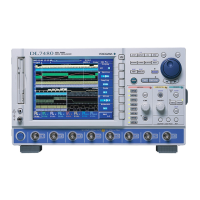2-1
IM DLM4038-02EN
2.1 Setting the Trigger Mode and Trigger Hold-off
Time
This section explains the following settings (which are used when updating the displayed waveform).
• Trigger mode
• Hold-off time
► “Trigger Mode (Trigger Mode)” and
“Trigger Hold-off (Holdoff)”
in the Features Guide
MODE Menu
Press MODE to display the following menu.
Set the trigger mode.
When the Trigger Mode
Is Set to N Single
Set the number of
Set the hold-off time.
Setting the Trigger Mode (Mode)
Auto: If the trigger conditions are met within approximately 100 ms, the DLM4000 updates
the displayed waveforms on each trigger occurrence. If not, the DLM4000 automatically
updates the displayed waveforms. If the time axis is set to a value that would cause the
display to switch to roll mode, the roll mode display will be enabled.
*
* For information about the time axis setting and the roll mode display, see chapter 3 of the Features
Guide, IM DLM4038-01EN.
Auto Level: If a trigger occurs before a timeout, the DLM4000 updates the waveform in the same
way that it does in Auto mode. If a trigger does not occur before a timeout, the DLM4000
automatically changes the trigger level to the center value of the trigger source
amplitude, triggers on that value, and updates the displayed waveform.
Normal: The DLM4000 only updates the waveform display when the trigger conditions are met.
N Single: The DLM4000 acquires signals each time the trigger conditions are met until a specified
number of signals have been acquired, and then displays all of the acquired signals.
Note
Press any of the trigger mode soft keys to execute waveform acquisition in the selected trigger mode.
Single mode
There is also a Single trigger mode in which the DLM4000 updates the displayed waveform once and stops
signal acquisition when the trigger conditions are met. Press SINGLE on the front panel to execute Single
Mode waveform acquisition.
Setting the Hold-off Time (Hold Off)
The trigger hold-off feature temporarily stops the detection of the next trigger once a trigger has
occurred.
Chapter 2 Triggering

